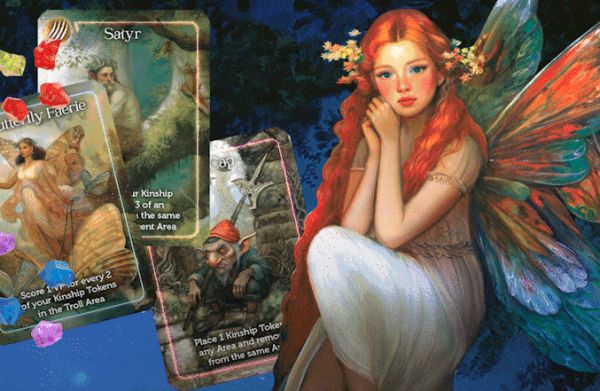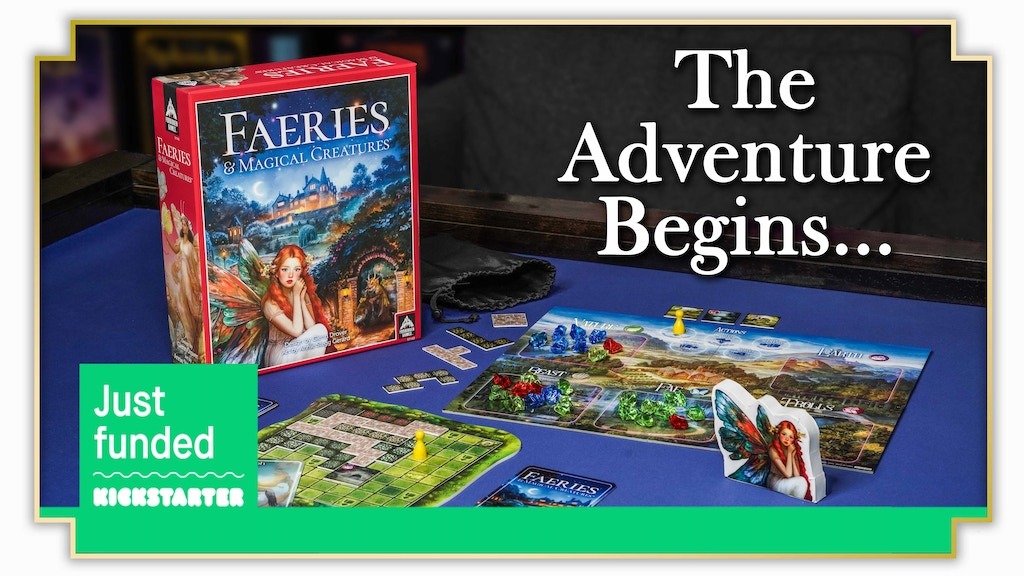Preview: Build a Garden and Make Magical Friends in Faeries & Magical Creatures

Make friends with unicorns, brownies, and faeries as you explore a magical realm of fantasy, build a garden, and earn the friendship of these faerie folk.
From Forbidden Games, and currently on Kickstarter, Faeries & Magical Creatures has elements of area control, deck building, and tile placement, with hand-painted artwork from Annie Stegg Gerard.
Gameplay
Each player has a garden board, four starting cards in their draw pile, and a supply of kinship tokens. On your turn, you may play a card and must choose an action, in either order. You may choose not to play a card, or to simply discard one without using its ability.
When you choose an action, you select one of five possible actions. After you have performed the action, all the other players also perform that same action.
One of the actions is calling faeries, in which case you draw cards from your personal draw deck until you have a hand of five cards. If your draw deck runs out while drawing, you shuffle your discard pile and form a new draw deck. The second action is helping hand, which means you play a card (so the active player has the chance to play two cards that turn). The third action is befriend a faerie, which allows each player to draft a card from the display. The display always has cards equal to the number of players, plus one. After every player has drafted one card and placed it in their discard piles, the remaining card is placed at the bottom of the draw deck and the display is refilled. The cards have different abilities, such as allowing you to manipulate kinship tokens or earning you points.
The fourth action is gain trust, which allows you to place one of your kinship tokens on one of the five faerie folk areas. The first player to have 10 kinship tokens in a faerie folk area, takes that faerie folk’s home tile and may place it on any empty space on his garden board. At the end of the game, the player with the most tokens in a faerie folk area earns one point for every token in that area regardless of who played it. The player with the second-most tokens in a faerie folk area earns one point for each of his own tokens at that location.
The final action is build your garden. There is one garden tile per player in the garden tile display. Each player selects one and then adds it to their gardens. The tiles come in different shapes and sizes and each tile is double-sided, with a plant on one side and a path on the other. The first path tile you place must have one edge along the edge of your garden board, and all future path tiles must be connected to a previously placed path tile. Plants can be placed anywhere in your garden that does not currently have a tile. However, at the end of the game, only plant tiles that have at least one edge connected to a path will earn points. A plant tile is worth one point for each square it takes up in your garden grid unless it is adjacent to a faerie home tile, in which case it is worth double. Once all players have finished placing their tiles in their gardens, the tile display is replenished.
Once you have resolved your optional card play and all players have taken the chosen action, it is now the next player’s turn. The game ends once all the faerie homes have been claimed, when there are not enough tiles or cards to replenish their respective display, or a when player has run out of kinship tokens. The player with the most points wins the game.

Review
Faeries & Magical Creatures is a lovely, light strategic game. There are intriguing choices layered throughout, but none of the actions at your disposal are complicated and the scoring system is nice and simple. The garden tiles are an excellent example of this. You just want the plants adjacent to the path and they are worth one point per space they take up in your garden. That’s it. This simplicity is refreshing. Design choices like this keep the game family-friendly and accessible. You don’t spend a lot of time at the end of the game calculating your garden points, or going through your deck to add up points from your cards.
There are some interesting abilities on the cards, such as scoring points based off what cards are in your discard pile at the moment that you play them, or removing tokens from specific faerie folk areas. Different cards belong to different groups of fairies, so there is some strategy in the type of deck you build. At the same time, you’re laying your tiles in your garden, and also dealing with that area control element. So, there’s a lot going on in the game, but it comes together neatly and different elements often play off of each other. For example, when you cover some spaces in your garden, you get to add more tokens to a faerie folk area, while those in turn can earn you a faerie house, which in turn can make your garden be more valuable.
The artwork in this game is absolutely gorgeous. Some of our favorite that we’ve encountered. It captures the theme beautifully, is rich, detailed, and serves the game well. After playing, we went through all the cards again, looking at the pictures. While some cards do share artwork, there’s still an impressive array of magical beings and creatures across the cards.
Games tend to be close, so your decisions are important. Which cards or tiles do you draft? How do you lay out your garden? Which faerie folk areas do you place your kinship tokens on and how do you respond to where other players place theirs? Since all players take the same actions, it is the details of those actions that are important (as well as how you use your cards). That tight back-and-forth interaction makes this a good two-player game, but it also works well at higher player counts.
It does feel like it takes a few turns to really get into the meat of the game, as the faerie folk areas fill and players' decks and gardens start to diverge more. Based on our interpretation of the rules, players don’t even start with any cards in hand, so there’s a buildup to even having cards to play. But once things get going, the game is engrossing. With streamlined actions and turns that involve everyone, the game moves along at a nice pace. Check it out on Kickstarter, at the very least to admire the beautiful illustrations, and judge the game for yourself.
Pros: Gorgeous artwork, accessible scoring system, the different mechanics are tied together well
Cons: The game takes a few turns to really get going
Disclosure: This is a paid preview of an unpublished prototype of this game, which is subject to change prior to publication.




